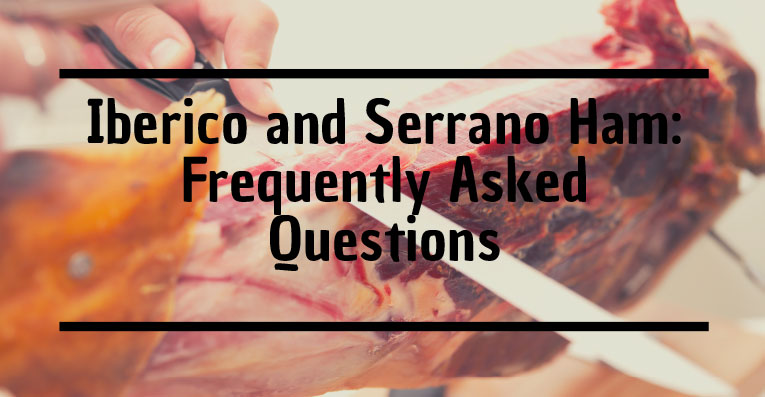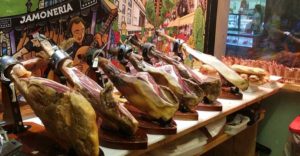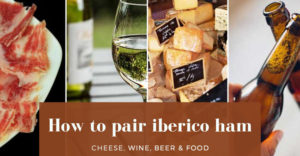In this FAQ´s, we took a lot of questions from our clients, searched for questions people ask in forums, other social media platforms and put them together for you. We hope we clarify all your doubts with this article about Iberico and Serrano Ham: Frequently Asked Questions.
FAQ´s
Serrano ham comes from a white pig. Eating cereal feeds and cured between 7 to 16 months, depending on producers. The breeds used on Serrano ham are usually Duroc, Pietrain, Landrace o Large White.
With the new regulation from 2014, only 100% of Iberico breed hams and shoulders will be able to be called Pata Negra
If you are thinking of buying an Iberico ham please read our article about Iberico Ham – ULTIMATE GUIDE 2019
The Iberian piglets start eating animal feeds, aromatic herbs. On the next phase of fattening, the acorn becomes the main source of their diet.
Iberico ham needs to be freeze with love, i will recommend than put it first on the fridge and them move it to the freezer. A big change in temperature will change the flavours of the ham and will ruin it.
If you can freeze block more than sliced ham will be recommended, because water will be filtered on the fibres of the ham if you freeze it sliced will change flavours. Cover the blocks with a bit with oil and wrapped with film paper.
When you want to defrost to eat the ham, make sure you respect the process back from freezer to fridge and the from fridge to ambient temperature. I have seen some people putting it in the microwave. Please avoid this practice.
If you want to know which cuts of Iberico and Serrano Ham are available to the public please visit our article about: How Serrano and Iberico hams are presented for consumption
Producers say than temperature is one of the most important key factors to keep the Iberico and Serrano ham. In my opinion, a stable temperature range between 10Cº to 15Cº will be optimum. Similar to the factory.
Keep far from insects, light, and an ideal place will a ventilated place
and the humidity around 75% (usually in every household).
The position needs to be vertical with the hoof in a top position. Please ask your supplier how long you can keep it without open it.
Ones you open the ham will be on the ham stand position.
When you start the ham, please keep those big pieces of fat when you cleaned and when finishing carving, put them back, as this fat will protect from drying, and cover with a dry cloth for optimal transpiration and optimal conservation. Do not cover with aluminium of foil paper. If you take a long time to eat, some mould will appear ( we will talk more in-depth below).
Mould usually appear for humidity, please avoid keeping it close from wet areas of the kitchen. Mould can be clean with a cotton cloth impregnated with a bit of olive oil, to protect the areas.
Ones the mould appears in cutting areas, just remove the first slice and continue cutting, we should not worry much about it. Cover with a thin cotton cloth to protect from humidity and oxidation.
You can cook some recipes, like stock with bones, add dried leftovers to your favourites stews, lentils, beans. Softer bits on scramble eggs, saute them with asparagus for salads or cooks some exquisite croquetas.
Please refer to your Doctor, the information we will give you is the one we know in the industry. Until now the pregnant woman is not immunized against toxoplasmosis ( you can detect it on the first blood analysis).
Will be recommended to avoid raw meats, bearly cooked, and also cured meats to prevent the disease, is not to harmfull for the mother but can be really dangerous for the fetus if it contracts during pregnancy.
News studies shows than the Iberico ham meat can be eaten because the long process of curation, but as we said before, please contact your Doctor
It is a product that is obtained by salting, I believe the times are from 11 days to 14 days. Once the salting process is finished, are taking to mountain houses to naturally air-drying and hang them from the hoof.
This process of curation can take between 36 to 42 months. Serrano ham is usually cured in fridges with controlled temperature and humidity
Piglets: An Iberian pig female will have during a year around 15 piglets, while a serrano ham bread will have around 25 to 30 piglets. The fixed cost will need to be shared between less animals.
Fat: due to the breed, a pure Iberian pig accumulates more subcutaneous and intramuscular fat percentage meat of 50%, much lower than a white pig (75%).
Living: an Iberico pig 100%, will eat acorns and will be a sacrifice with 160 kg and will live around 24 months, while a white pig will live 8 months and sacrifice between 90 to 110 kg. An Iberico pig lives in the Dehesa, run and walks freely.
Habitat: approximately an Iberian pig in the Montanera season need 2 hectares of Dehesa plenty of acorn trees (around 2 and a half football field). White pigs grow and leave mostly in close envoirements
Curation: and Iberico Ham bellota of 7.5 kg takes 36 to 42 months. A white pig 8 to 12 months.
Bellow, we described how long it last sliced vacuum pack, ones you open the pack or any other sliced ham, I will recommend eating within a week. Keep always on the fridge, but take out 1 hour before, the amount of ham you want to eat.
This will depend if the vacuum comes directly from the factory, butcher or other sources. Usually, the time to eat will be between 60 to 90 days. Some suppliers give 6 months on modified atmosphere packaging.
Always look at the supplier instructions, if is not any, please contact the seller.
If the pack have lost the vacuum, see than the colour, the smells are good. If you order it online, please contact your supplier
You can cook a lot of different recipes, if the bits are really hard and dry, add them to lentils, beans or any stews when cooking will rehydrate and the most important will give a special taste to your dishes.
Other softer bits, you can use to prepare toast with tomato, scrambled eggs, croquetas, salads. Soon we will have our recipes blog, please contact s if you have any recipe then you want us to cook and post an article.
Every supplier will vary a little bit, but if we need to give an estimated figure, for every 100g of Iberico ham Bellota, will be 250 kcal.
Eaten Iberico ham will not be a problem for low-calorie diets.
The downside is than contains salt, but this type of ham has between 2.5% to 4.5%. The other ham contains around 5%.
According to scientific studies, the fat of Iberico ham bellota (acorns), has more than 55% of oleic acid, and produces a beneficial effect on blood cholesterol and raise the rate of good cholesterol (HDL).
Also is a source of protein, vitamins B1, B6, B12, folic acid, necessary to a good function of the brain. Rich in Vitamin E (antioxidant), minerals like copper, calcium, iron, zinc, magnesium, phosphorus and selenium.
Experts say than we can eat in small amount 2 to 3 days a week.
White dots are crystallizations formed by an amino acid called tyrosine that appears during the protein degradation. they are not dangerous or harmful at all. In the main time, those dots tend to denote optimal healing and maturation.
In a leg of ham, the amount we can eat will be around 45%, so 55% will be bones, Hoff, fats, outer skin, excess fat (not eatable).
In a shoulder, the amount we can eat will be 35%, and 65 will be bones, Hoff, fats, outer skin, excess fat (not eatable).


